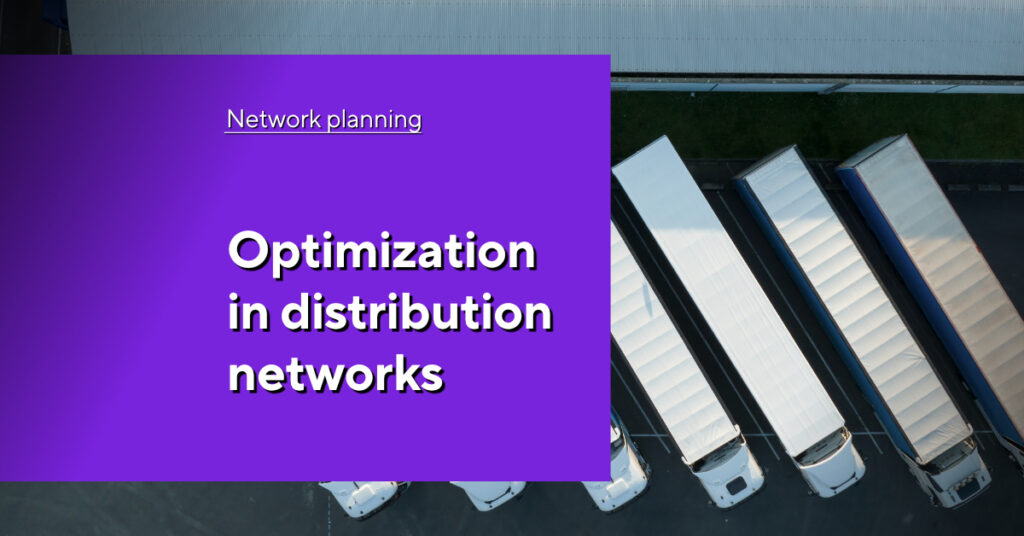Mathematical optimization for facility location planning
Facility location planning is a critical strategic decision in network planning in order to find the right location and capacities for manufacturing facilities, warehouses or branches after considering all the possible alternatives. Companies see it as a means to strengthen their networks and supply chains, to maximize opportunity and minimize costs and risks in order to achieve their business objectives. However, research has shown that the failure of many companies can largely be attributed to inadequate location planning.
From expansion to relocating:
consider all possible options
Whether location planning concerns manufacturing sites, branches, warehouses or distribution centers, the challenge is usually to balance competing objectives. These could be:
- to have as few locations as possible to utilize economies of scale
- to have prime locations closer to customers and /or suppliers,
- to ensure a constant supply of raw materials needed for manufacturing
- to shorten routes to attain low transport costs and have fast response times, therefore meeting customer demand which ensures business success and a competitive advantage.
There are various choices available when it comes to location planning. A company can expand an existing location to accommodate a larger warehouse or production facilities. Another option is to add new locations – at home and/or abroad – while still maintaining the existing ones. One or more locations can be shut down and replaced with new ones elsewhere.
Once the choice of how to locate has been made, a company needs to analyze all of the possible locations in order to make a decision. This means taking a multitude of factors into account which can be divided into two groups – the hard and soft factors. Below we take a look at the most important factors in both groups in more detail below.
The hard factors
Hard location factors are quantifiable and can be included in a company’s KPIs or balance sheet in order to measure profitability. They have a direct impact on a company’s activities and are thus considered to be important pre-requisites in location planning. The most important hard factors in location planning are:
1. Proximity to suppliers and customers
The closer a company is to its raw materials supplier, the more it can be sure of a steady production workflow and of guaranteeing delivery reliability. Proximity to customers means transport routes are shorter and delivery times are faster.
2. Transport connections
Quick and easy access to transport facilities ensures speedy delivery and reduced costs. A company with a large domestic market or an online trader which depends on fast response times will be looking at the proximity to road or rail networks for its distribution centers, for instance. Companies which rely on exporting goods, on the other hand, would focus on locations from which they have access to container ports or airports.
3. Utilities/Infrastructure
A company must take the entire infrastructure of the location into account. This includes among others the supply of power/gas/water, etc. For example, chemical manufacturing facilities or paper mills require water in vast amounts and of good quality as well as an efficient waste disposal facility nearby. Heavy industrial companies would tend to locate closer to areas where the necessary raw materials are readily available. Aspects such as advanced technology also play a role – for example poorer regions abroad may not have a particularly good tele-communications network.
4. Labor and wages
The human resources pool in the region in which a business plans to locate must be assessed in advance to determine the availability of skilled workers in the area. A further question to consider is how high/low average wages are. Another aspect which is particularly important when relocating abroad is to have information on national insurance payments and how regulated industrial relations are.
5. Taxes and Subsidies
Many businesses also take advantage of the tax breaks or subsidies offered in certain countries or regions when it comes to location planning. Which local taxes would a business be subject to paying? Particularly when relocating to foreign countries, it is essential to be aware of tax regulations that apply in the respective country. Many governments will also offer subsidies as an incentive to businesses to settle there. Setting up a facility in free trade zones can also be of benefit as customs duties and levies would be low or non-applicable.
6. Environmental policies
These have become a hard factor to consider in recent years since the introduction of stringent environmental policies and requirements that businesses have to meet. Which costs need to be invested in the construction of a new manufacturing facility so that the new facility meets all environmental regulations? Another consideration is the environmental standards in the region or country in which you wish to settle? For example, how will your sales be affected if you produce in a country in which environmental policies are not as advanced as your home country? Will consumers boycott your products if they are not manufactured sustainably?

Are you interested in our factsheet?
What are the benefits of mathematical optimization?
The soft factors
While the soft location factors are not quantifiable and thus cannot be considered in a company’s long-term business planning strategy, their significance should not be under-estimated:
1. The political and cultural situation
This factor is particularly relevant when establishing branches or new manufacturing facilities abroad. The following questions require consideration: How stable is the country/region politically? Are there any cultural traditions which could have an effect on production (e.g. national holidays which could hold up production or delivery?) No less important: What image does the country have? For example, it can be detrimental to produce in a country under authoritarian rule with a poor human rights track record as this could lead to consumers boycotting your products.
2. Living quality
The quality of life in the region in is key to convincing talented workers to relocate there. What are the cultural/freetime amenities available? What child-care facilities are available? Is there a good public transport network? How high are the living costs for rent, etc? A rural town in the middle of nowhere may not be an incentive for people to relocate. On the other hand, moving to an area with extremely high living costs can also be a deterrent.
3. Business Relations
Being located in the vicinity of companies in the same business or in related ones can be advantageous in that they can provide support or the possibility to find cooperation partners. On the other hand, being too close to the competition can weaken your business also.
4. Business Climate
How innovative is the region you are considering locating to? Does it have a good reputation for innovation and advanced technology? It is also worth considering just how easy or difficult it may be to work with the local authorities, particularly in foreign countries. How fast can applications be granted? Slow bureaucracy can be harmful to your production processes if you have to wait for permission to be granted, etc.
More interesting articles
Digitized location planning
All of the above factors, both hard and soft, have to undergo precise scrutiny, the relevant questions have to be answered and the multitude of possible combinations have to be analyzed to select the optimal location. Companies will often call in many different professionals to assist them: from lawyers and accountants, to local authorities, trade associations and even environmentalists or pressure groups. Their job is to go through all of the relevant factors involved in location planning with a fine toothcomb. However, the vast amount of data to be evaluated is time-consuming and a highly complex matter. It is also prone to human error. By digitizing, i.e. optimizing the entire location planning process with advanced software, a sound and efficient location strategy can be developed quickly and easily.
Finding the right location with mathematical optimization
Using mathematical optimization you can get the best location planning results within a very short time. An optimization platform such as OPTANO, which deploys advanced mathematical optimization techniques such as predictive and prescriptive analytics as well as state-of the-art algorithms can support the decision-making process here and find the optimal solution to facility planning problems.
To do this, a mathematical model of the existing business is created. This is based on all the available business data and simulates the company’s entire network and supply chain including factories, suppliers, inventory, distribution centers, branches, customers, etc. Flexible parameters – products, logistics, human resource pools, and many more – are used to manage the conditions for selecting a location, always with the goal of optimized location planning in mind.
Once the model has been created it is then possible to compare all the location possibilities in what-if scenarios to determine which locations are suitable, what the other alternatives could be, how the business objective would be affected if certain assumptions were added or removed, etc. Interactive maps and charts can be used to add or exclude simulated locations, remove certain conditions and analyze the outcome of each scenario. Once the scenarios have been evaluated, the system provides the best results on whose basis a company can select the optimal location(s) to achieve its business objectives.
The way towards the optimal location – with OPTANO every step of the way
OPTANO is a platform which deploys highly sophisticated mathematical optimization techniques to ensure that your location planning is a success. However, this is not all that OPTANO can offer. It also provides optimal solutions to your entire network planning (of which location planning is just one aspect) as well as to your production planning and supply chain management.
And of course our OPTANO consultants and experts accompany you right through the entire planning process and beyond. Why not contact Dominik Hollmann, who would be happy to answer any questions you may have.
Also, if you would like to learn more about how mathematical optimization can benefit your business, why not download our factsheet “What are the benefits of mathematical optimization?”
Do you already know our factsheet on this topic?

In our factsheet “What are the benefits of mathematical optimization?” we ask 5 questions to help you assess whether mathematical optimization brings benefits to your organization.
To obtain our factsheet, all you need to do is enter your contact details in the space below. A pop-up window will then open to download the whitepaper. Please note that by providing us with your email address, you agree that we may contact you on this topic. You may revoke this agreement at any time by contacting privacy@optano.com.






